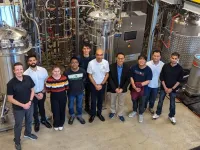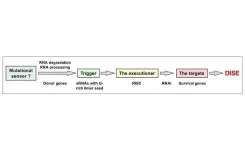(Press-News.org) A session at this year’s Annual Meeting of the European Association for the Study of Diabetes will explore the latest data on the concept of metabolically healthy obesity (MHO) – more commonly known by the public as ‘fat but fit’. Professor Matthias Blüher, University of Leipzig, Leipzig and Helmholtz Center Munich, Germany will explain how we define MHO and ask if it can really be described as healthy.
“Some 15-20% of people living with obesity have none of the metabolic complications we associate with the condition, namely abnormal blood sugar control and blood fats, high blood pressure, type 2 diabetes and other signs of cardiovascular disease,” explains Prof Blüher.
Estimates suggest a different prevalence of MHO in men and women, with women living with obesity more likely to have MHO (7-28%) than men (2-19%). At the other end of the spectrum, around half of people living with obesity have at least 2 complications. For a given total body fat mass, people with MHO have lower liver fat mass (thann expected for the BMI and total fat mass).
Prof Blüher will discuss that is how the adipose tissue behaves in people with obesity, rather than their body-mass index, that will determine whether or not their obesity is MHO. In people with adipocytes (fat storing cells) that are of a normal size, those people are less likely to display the complications of obesity – whereas in people with enlarged adipocytes and inflamed adipose tissue, these cells are more likely to exhibit traits such as insulin resistance that lead to metabolic complications.
And the way that we store fat is likely key in whether or not obesity can be described as MHO. “When people with obesity have fat stored viscerally, or internally around their organs (such as in the liver), the data show that these people are much more likely to develop type 2 diabetes than those who store fat more evenly around their body,” says Prof Blüher.
He goes on to explain that in people with adipose tissue dysfunction, this can lead to damaged tissue, fibrosis, secretion of proinflammatory and adipogenic molecules that subsequently contribute to end-organ damage. As an example, adipokines (fat released hormones) may act directly on cells of the vascular system and lead to atherosclerosis. In addition, metabolites such as fatty acids may impair the function of liver or insulin-producing cells in the pancreas.
Finally, on the key question as to whether or not MHO can genuinely be described as healthy, Prof Blüher will explain that several studies show that compared with people of normal weight with no metabolic comorbidities, people living with obesity with no metabolic comorbidities have a 50% increased risk of coronary heart disease. “So there is still a residual increased risk for those people living with obesity, even with what we would call metabolically healthy obesity,” he says.
In conclusion, there are people with obesity that do not exhibit cardio-metabolic complications at a certain point in time. In the past, the diagnosis of MHO frequently led to a low priority for obesity treatment. This concept has been challenged, because recent data suggest that the term metabolically healthy obesity is misleading. He concludes: “Even in the absence of other cardiometabolic risk factors, increased fat mass and adipose tissue dysfunction contribute to a higher risk of type 2 diabetes and cardiovascular diseases. Therefore, weight management and recommendations for weight loss are still important for people living with metabolically healthy obesity.”
This press release is based on session S24 to take place in the Hamburg Hall at the European Association for the Study of Diabetes (EASD) Annual Meeting in Hamburg at 0900H AM CEST on Wednesday 4 October. The presenter is happy to answer any questions.
Prof Blüher will also take part in the embargoed press conference taking place at 1200H Noon CEST Hamburg time on Tues 3 Oct, in the Vienna Hall.
END
Metabolically healthy obesity: fact or fiction?
2023-10-04
ELSE PRESS RELEASES FROM THIS DATE:
Emergency department screening could detect thousands of undiagnosed prediabetes and diabetes cases, UK study suggests
2023-10-04
The introduction of screening for type 2 diabetes in Accident and Emergency (A&E) departments could uncover thousands of previously undiagnosed cases every year, suggests new research being presented at this year’s Annual Meeting of The European Association for the Study of Diabetes (EASD), Hamburg (2-6 Oct).
“Early diagnosis is the best way to avoid the devastating complications of type 2 diabetes, and offers the best chance of living a long and healthy life”, says Professor Edward Jude, Tameside and Glossop Integrated Care NHS Foundation Trust, UK. “Symptoms of type 2 diabetes may be absent and can be tricky ...
New stem cell-derived islet therapy improves blood sugar control in all treated patients, with three achieving insulin independence
2023-10-04
Six adults with type 1 diabetes (T1D) treated with stem cell-derived islet cells (VX-880) have shown improved blood sugar control with three participants achieving insulin independence, according to new research being presented at this year’s Annual Meeting of The European Association for the Study of Diabetes (EASD), Hamburg (2-6 Oct).
All patients treated with VX-880 have demonstrated improved glycaemic control, as evidenced by elimination of severe hypoglycaemia (low blood sugar), improvements in HbA1c (a measure of long-term sugar levels) and the amount of time their ...
New pipeline makes valuable organic acid from plants — saving money and emissions
2023-10-03
In a breakthrough for environmentally friendly chemical production, researchers at the Center for Advanced Bioenergy and Bioproducts Innovation (CABBI) have developed an economical way to make succinic acid, an important industrial chemical, from sugarcane.
The team of University of Illinois and Princeton University researchers created a cost-effective, end-to-end pipeline for this valuable organic acid by engineering a tough, acid-tolerant yeast as the fermenting agent, avoiding costly steps in downstream processing. Succinic acid is a widely ...
PARMESAN: An AI-based predictive tool to find new treatments for genetic disorders
2023-10-03
To discover new treatments for genetic disorders, scientists need a thorough knowledge of prior literature to determine the best gene/protein targets and the most promising drugs to test. However, biomedical literature is growing at an explosive rate and often contains conflicting information, making it increasingly time-consuming for researchers to conduct a complete and thorough review.
To address this challenge, Cole Deisseroth, a graduate student enrolled in the M.D./Ph.D. program and mentored by Drs. Huda Zoghbi and Zhandong Liu at the Jan and Duncan ...
PPPL awarded $5 million to lead an Energy Earthshot Research Center focused on clean hydrogen
2023-10-03
Lessening the effects of climate change will require a variety of innovations and a lot of ingenuity. Now, a new center led by the U.S. Department of Energy’s (DOE) Princeton Plasma Physics Laboratory (PPPL) will help these efforts by advancing the understanding of plasma-based clean hydrogen production.
PPPL was selected to lead a DOE Energy Earthshot Research Center (EERC) as part of the Hydrogen Shot™, which aims to reduce the cost of hydrogen by 80%. With funding from the DOE’s Office of Science, the EERCs support fundamental ...
Illinois-led project to sequence 400 soybean genomes, improve future crops
2023-10-03
As a source of protein and biodiesel for cleaner renewable energy, soybean is an important crop worldwide. But is it performing to its full potential? An ambitious effort led by the University of Illinois Urbana-Champaign and the U.S. Department of Energy Joint Genome Institute (JGI) will sequence 400 soybean genomes to develop a “pangenome” — an attempt to characterize all the useful diversity in the genome to create an even more robust and resilient crop.
The soybean pangenome project will sequence and analyze at least 50 soybean genomes from cultivated lines and wild relatives at reference quality, the gold standard of modern sequencing. A further ...
An ancient anti-cancer mechanism: DISE
2023-10-03
“DISE is effective against all cancers we tested.”
A new editorial paper was published in Oncotarget's Volume 14 on September 25, 2023, entitled, “DISE, an ancient anti-cancer mechanism that senses mutational load in cancerous cells?”
In their new editorial, researchers Monal Patel and Marcus E. Peter from Northwestern University discuss a recent breakthrough in cancer therapy. Despite the multiple advances in therapy, cancer remains one of the most common causes of death globally. ...
Project aims to develop all-in-one semiconductor that stores, processes data
2023-10-03
A multi-institutional project led by a Penn State researcher is focused on developing an all-in-one semiconductor device that can both store data and perform computations. The project recently received $2 million in funding over three years as part of the new National Science Foundation Future of Semiconductors (FuSe) program, a $45.6 million investment to advance semiconductor technologies and manufacturing through 24 research and education projects across the United States.
“The goal of ...
Nemours Children’s Health hosts first-ever pediatric session at HLTH
2023-10-03
Nemours Children’s Health will host the first-ever dedicated pediatric session at HLTH, the leading platform bringing together the entire health ecosystem focused on health innovation and transformation. This invited program, “Elevating Kids Health Well Beyond Medicine,” will extend HLTH’s 2023 theme, “Elevating Humanity,” to focus on health in childhood and why it is the only way to build good health across the lifespan.
“The child health perspective is an essential viewpoint for the attendees of HLTH to consider and we are proud to offer ...
OU Engineering among top 28 teams nationwide selected for DEPSCoR Grant
2023-10-03
University of Oklahoma engineering researcher Reza Foudazi, Ph.D., has been selected to receive a $600,000 grant from the U.S. Department of Defense under the Defense Established Program to Stimulate Competitive Research, or DEPSCoR. The highly competitive grant was awarded to only 28 academic teams nationwide.
An associate professor in the School of Sustainable Chemical, Biological and Materials Engineering, Foudazi’s research centers on the exploration of electrochemical energy storage systems that incorporate multivalent ions. ...




